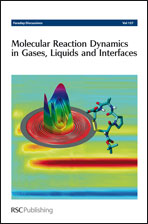Multi-path variational transition state theory for chemical reaction rates of complex polyatomic species: ethanol + OH reactions†
Abstract
Complex molecules often have many structures (conformations) of the reactants and the transition states, and these structures may be connected by coupled-mode torsions and pseudorotations; some but not all structures may have hydrogen bonds in the transition state or reagents. A quantitative theory of the reaction rates of complex molecules must take account of these structures, their coupled-mode nature, their qualitatively different character, and the possibility of merging reaction paths at high temperature. We have recently developed a coupled-mode theory called multi-structural variational transition state theory (MS-VTST) and an extension, called multi-path variational transition state theory (MP-VTST), that includes a treatment of the differences in the multi-dimensional tunneling paths and their contributions to the reaction rate. The MP-VTST method was presented for unimolecular reactions in the original paper and has now been extended to bimolecular reactions. The MS-VTST and MP-VTST formulations of variational transition state theory include multi-faceted configuration-space dividing surfaces to define the variational transition state. They occupy an intermediate position between single-conformation variational transition state theory (VTST), which has been used successfully for small molecules, and ensemble-averaged variational transition state theory (EA-VTST), which has been used successfully for enzyme kinetics. The theories are illustrated and compared here by application to three thermal rate constants for reactions of ethanol with hydroxyl radical—reactions with 4, 6, and 14 saddle points.
- This article is part of the themed collection: Molecular Reaction Dynamics in Gases, Liquids and Interfaces

 Please wait while we load your content...
Please wait while we load your content...